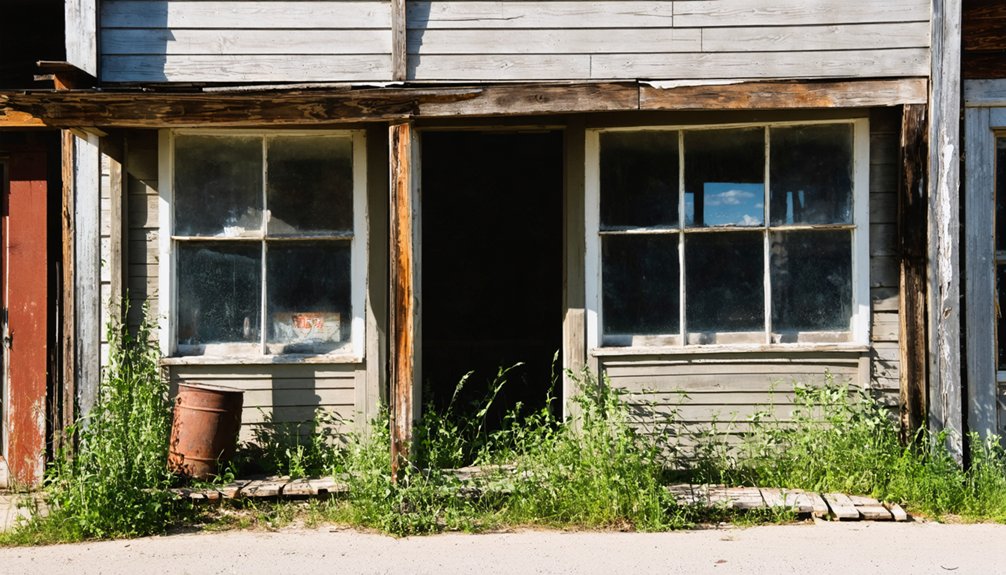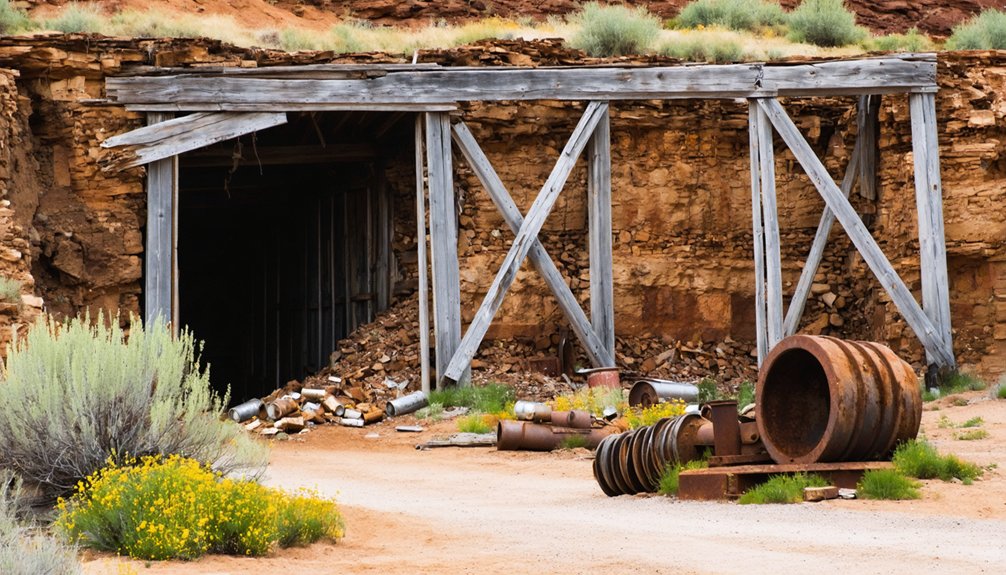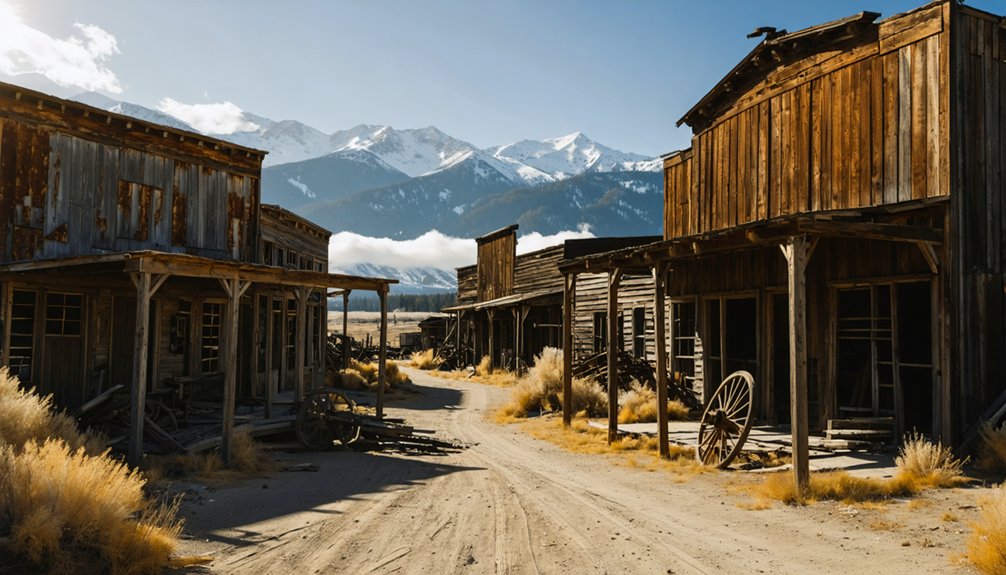You’ll find Geneva City’s ruins at 12,400 feet in Colorado’s Rockies, abandoned after the 1893 silver crash ended its gold rush prosperity. Access this remote ghost town via Geneva Creek Trail to explore weathered structures including a two-story boarding house and a 1946 International truck. The site lacks formal protection, so visit respectfully while photographing these remnants of mining families who endured extreme conditions. The town’s forgotten stories await beneath every collapsed timber.
Key Takeaways
- Geneva City was established during the Pike’s Peak Gold Rush of 1859 and later transitioned to coal mining operations.
- Mining families endured extreme high-altitude conditions with men working underground while women maintained households.
- The town declined after the 1893 silver devaluation and suffered from transportation isolation as railroads bypassed it.
- Remnants include a two-story boarding house and an abandoned 1946 International truck marking its past mining activities.
- Visitors should follow the Geneva Creek trailhead, bring navigation tools, and be cautious of unstable structures.
The Gold Rush Legacy of Geneva City
When prospectors first arrived in Geneva City following the Pike’s Peak Gold Rush of 1859, they couldn’t have imagined the boom-and-bust cycle that would define this frontier settlement.
Drawn by gold discoveries near Idaho Springs and Central City, miners established Geneva as a thriving community in Clear Creek County.
The promise of golden riches lured fortune seekers to Geneva, transforming an untamed valley into a bustling mining settlement.
You’ll find that Geneva City’s economy was built entirely on mineral extraction. Similar to what happened in California, the news of gold in Colorado spread rapidly, leading to a significant influx of miners seeking fortune in the Rocky Mountains.
Early gold rush mining techniques were primitive but effective—starting with simple panning in local streams before advancing to hydraulic methods.
As surface gold diminished, miners faced increasing challenges from the Rocky Mountains’ harsh environment and complex sulfide ores. Many miners relied on private minters like Clark, Gruber & Co. who produced gold coins that were often preferred over federal currency.
Journey to a Hidden Mining Community
Your journey to Geneva City requires traversing the challenging Geneva Creek Trail, a rugged path marked by steep inclines and treacherous creek crossings that demand sturdy hiking boots and careful footing.
You’ll need to pack essential survival gear including water, high-energy snacks, first aid supplies, and weather protection given the area’s notorious rapid climate shifts.
The final approach reveals itself when you spot the historic cabin near the creek crossing, signaling your arrival at this remote mining community hidden among the mountains of Clear Creek County. Located at 39.5739°N, 105.8132°W, this abandoned settlement still features some original structures that have weathered decades of mountain seasons.
Situated at approximately 11,600 feet elevation, Geneva City offers visitors a true high-altitude ghost town experience that’s relatively close to Denver.
Accessing Remote Ruins
Reaching the forgotten remains of Geneva City presents a formidable challenge that rewards only the most determined explorers.
You’ll need a high-clearance, four-wheel-drive vehicle to navigate the steep, rocky terrain with loose sections that threaten to strand the unprepared. The unmaintained mining tracks that serve as your final approach deteriorate quickly after precipitation.
Navigation demands vigilance, as few signs mark the way through a maze of branching mining roads. Look for the landmark cabin near the creek crossing to confirm you’re on track.
Cell service vanishes in these remote reaches, so bring detailed maps or GPS. Remember Georgetown is miles away, with no services or utilities awaiting at the ruins.
This seasonal remote access requires self-sufficiency – pack all essentials and prepare for trail conditions that change with little warning. The 6.8-mile one-way journey along Geneva Creek Trail offers moderate difficulty but stunning natural vistas. Like other remote off-road destinations throughout Colorado, proper preparation ensures you can safely explore these historical treasures.
Treacherous Creek Crossings
The most formidable obstacle on your journey to Geneva City lies not in the rugged terrain alone, but in the unpredictable creek crossings that guard this ghost town’s secrets.
You’ll encounter poorly marked routes with multiple unmarked trail intersections that can easily lead you astray.
Geneva Creek presents treacherous currents that vary dramatically by season—from ankle-deep in late summer to waist-high during spring runoff.
Proper crossing techniques are essential: scout the water first, maintain steady momentum, and enter at a slight downstream angle. Your high-clearance 4WD vehicle will be tested against shifting debris and unstable riverbeds.
Look for the lone cabin on the passenger side as your confirmation of the correct crossing point.
This historic mining camp from 1860 still has some remaining structures visible at its impressive 11,585 ft elevation.
Pack Survival Essentials
Five critical survival categories must be addressed before starting your expedition to Geneva City’s isolated mining ruins. Your survival gear should include clothing that adapts to mountain temperature fluctuations, with waterproof outer layers and moisture-wicking base layers.
Don’t underestimate the remote location‘s demands on your essential packing strategy.
- Carry minimum 2 liters of water per person daily, plus purification methods for creek water refills.
- Pack navigation redundancies: topographic maps, compass, and GPS with offline maps.
- Include emergency shelter options like a space blanket or bivy sack, even for day hikes.
The journey demands proper hiking boots with ankle support for traversing rough terrain and creek crossings.
Your pack should contain a headlamp, whistle, and first aid supplies for unexpected situations. The area’s history of mining innovations is evidenced by the selective flotation techniques first used in North America at nearby operations.
Life in the Rocky Mountain Boomtown
Mining families in Geneva City faced extreme challenges as they navigated life in high-altitude conditions with limited resources.
You’d find households structuring their entire existence around mining shifts, with women maintaining homes while men worked dangerous jobs extracting gold, silver, and iron from mountain veins.
The well-preserved bunk beds, oil lamps, and stocked shelves discovered in 1959 reveal how these resilient families adapted to Rocky Mountain isolation through practical self-sufficiency and communal interdependence.
Miner Family Dynamics
While life in Geneva City’s boom days centered around extracting precious metals from the earth, family dynamics shaped the social fabric that held mining communities together.
You’d find distinctive family roles emerge within these mountain settlements, with women maintaining domestic life while men labored underground. The presence of women and children made mining camps more comfortable and civilized compared to settlements with only single men. When accidents occurred, like the roof fall incident that took lives in Pictou, the community’s support became even more crucial.
Family sizes typically ran large, with:
- Five children considered a small family, while some households raised 12-15 children
- Boys as young as 11 entering mines alongside their fathers, child labor being commonplace before protective laws
- Girls staying home to care for younger siblings, often sacrificing their education
Many households descended from immigrants who brought mining experience and cultural traditions.
When tragedy struck—as it frequently did in these dangerous occupations—the entire community rallied to support widows and children, demonstrating the interdependence that defined mining town resilience.
Harsh Mountain Survival
Beyond the intimate challenges of family life, Geneva City residents faced an environment that tested human endurance at every turn.
You’d awaken to sub-zero temperatures in poorly insulated dwellings, where frost often coated interior walls. Your survival techniques necessarily included communal snow removal, water collection before freezes, and strategic resource management when supplies dwindled.
You couldn’t count on consistent food deliveries when avalanches blocked mountain passes for weeks. Instead, you’d rely on preserved stores, community food sharing, and whatever game hunting might yield.
When medical emergencies struck, you’d turn to folk remedies and neighbor knowledge rather than doctors. The harsh Rocky Mountain winters forced you to adapt constantly—chopping scarce firewood, repairing snow-damaged roofs, and maintaining vigilance against frostbite and hypothermia that claimed many unprepared settlers.
Abandoned Cabins: a Glimpse Into the Past

Hidden among the rugged terrain of Geneva City, the abandoned cabins stand as time capsules of early 20th-century mining life.
These modest 12-by-18 foot structures have withstood a century of harsh mountain conditions, with cabin preservation efforts now battling natural deterioration and safety concerns.
When you explore these remnants, you’ll discover:
- Well-preserved log cabins with original bunk beds and hand-crafted furniture
- Mining artifacts including tools and even a 1946 International truck nearby
- Evidence of hasty departures—locked doors and stocked shelves suggesting lives interrupted
The cabins reflect the functional priorities of mining communities, where workers lived mere steps from their claims at 11,600 feet elevation.
Today, these structures attract history enthusiasts who document and sometimes informally restore these windows into Colorado’s mining heritage.
Mining Operations and Economic Rise
At the heart of Geneva City’s meteoric rise stood its complex mining operations, which transformed this remote mountain settlement into a thriving economic center during the late 1800s.
When you explore the town’s history, you’ll find the Stevens Lode discovery in 1868 sparked remarkable mining innovation, with tunnels extending 500 feet below the surface at 12,400 feet elevation.
The town underwent significant economic transformation as operations shifted from precious metals to industrial coal mining by the 20th century.
From precious metals to industrial coal, Geneva City’s economic soul transformed with the shifting demands of a new century.
The Geneva Mine eventually reached a capacity of 8,500 tons of coking coal daily, with 6,500 tons feeding the Geneva Steel Mill.
This industrial evolution brought sophisticated infrastructure—multi-level mines, tramways, sorting buildings, and rapidly constructed railroad spurs that connected the isolated mountain operations to broader markets.
The Mysterious Exodus: Why Residents Left

The departure of Geneva City‘s once-vibrant population remains among Colorado’s most compelling historical puzzles, though economic factors clearly played the decisive role.
As you explore the ghost town today, you’ll see evidence of the economic hardships that forced residents to seek opportunities elsewhere.
- The mines that once promised prosperity began yielding diminishing returns by the late 19th century, with the 1893 silver devaluation delivering a devastating blow to the town’s primary industry.
- Transportation isolation sealed the town’s fate as railroads bypassed Geneva City, making it increasingly difficult to sustain commerce.
- Community decline accelerated as essential services shuttered—schools closed, merchants departed, and social bonds weakened—creating a domino effect that made staying increasingly untenable.
The harsh mountain environment only compounded these challenges, making Geneva City’s abandonment virtually inevitable.
Winding through the rugged terrain of Pike National Forest, Geneva Creek Trail offers modern adventurers a journey into Colorado’s mining past while presenting moderate physical challenges.
You’ll find the trailhead off Highway 46 south of Georgetown, marked by a distinctive cabin near the creek crossing.
For successful trail navigation, carry a topographic map or GPS device, as cell service is unreliable in these remote areas.
Hiking safety demands preparation—pack water, food, appropriate clothing, and first aid supplies. Stay on established paths to avoid abandoned mining hazards.
The reward for your effort includes exploring Geneva City’s ghost town with its preserved cabins, the old ski patrol hut, and spectacular natural scenery.
Historic remnants and natural beauty await as you discover Geneva City’s abandoned past amid Colorado’s breathtaking wilderness.
Plan your hike during daylight hours and consider weekday visits to enjoy this historical treasure with fewer crowds.
Artifacts and Structures That Remain

When you explore Geneva City today, you’ll find the remnants of domestic life captured in the two-story boarding house that survived at least into the 1980s.
The abandoned 1946 International truck serves as a silent sentinel to the site’s past activities, marking a shift between the town’s active years and its gradual decline.
Hidden among overgrown vegetation, scattered mining tools, building materials, and campfire remains offer glimpses into the daily routines of this high-elevation community that once thrived at 11,600 feet.
Frozen In Time
Hidden among the pines and peaks of Pike National Forest, Geneva Basin and Geneva City linger as ghostly time capsules, preserving fragmentary evidence of two distinct economic eras in Colorado’s history.
These frozen moments offer glimpses into Colorado’s mining boom and recreational evolution.
When exploring these abandoned sites, you’ll encounter:
- The old ski patrol hut – the sole surviving structure from Geneva Basin’s resort era, dirty but functional
- Visible ski runs carved into mountainsides – still used by backcountry enthusiasts seeking powder freedom
- Mining remnants near Geneva City – abandoned shafts, equipment, and a landmark cabin past the creek crossing
These artifacts create a time capsule effect, allowing you to physically connect with pioneers who extracted wealth from these mountains and later generations who found joy descending them.
Domestic Life Remains
Despite decades of abandonment, Geneva City’s domestic structures remain remarkably intact, offering visitors a rare window into the daily lives of its former mining residents.
You’ll find houses with original locks still securing doors—evidence of domestic security concerns in this remote settlement. Inside, hand-crafted bunk beds reveal the communal living arrangements typical of mining communities, while tables with oil lamps showcase pre-electric lighting solutions.
The small, functional homes contain surprising treasures: shelves still stocked with canned goods, personal mining tools, and collected minerals including “fool’s gold.”
These artifacts illustrate a self-sustaining lifestyle where craftsmanship was essential. The preserved interiors of these humble dwellings tell a compelling story of adaptation and resilience in a challenging mountain environment, where both natural resources and human ingenuity shaped everyday existence.
Preserving an Unprotected Historical Treasure
Although Geneva City represents a significant piece of Colorado’s mining heritage, its preservation faces substantial challenges due to its lack of formal protection.
Weather, vandalism, and neglect continue to threaten the remaining structures, with limited resources available for maintenance.
Community involvement remains essential to Geneva City’s survival as an historical site.
You’ll find that preservation challenges are often addressed through:
- Volunteer-led documentation efforts and informal monitoring by local historical enthusiasts
- Community-organized stabilization projects that help reinforce deteriorating structures
- Educational initiatives that raise public awareness about respectful visitation practices
Without dedicated funding or coordinated government oversight, the fate of this unprotected treasure depends largely on public respect and grassroots conservation efforts.
The site’s continued existence relies on visitors who appreciate its historical significance without contributing to its decline.
Photography and Exploration Tips for Visitors

When visiting Geneva City, you’ll discover that the ghost town provides photographers with extraordinary opportunities to capture Colorado’s mining past through thoughtful composition and proper timing.
Arrive during early morning or golden hour to maximize the soft, warm light that enhances weathered textures and creates dramatic shadows across abandoned structures.
Your exploration gear should include a wide-angle lens for capturing expansive views and cramped interiors, plus a tripod for low-light photography techniques.
Don’t forget weather-sealed equipment and polarizing filters to manage glare.
Follow the main Geneva Creek trailhead to access key vantage points, but remain vigilant of your surroundings—unstable structures and wildlife pose real hazards.
Wear sturdy footwear and carry navigation tools since cell service is unreliable in this remote landscape.
Frequently Asked Questions
Were Any Notable Historical Figures Connected to Geneva City?
No famous residents are documented in Geneva City’s history. The town’s significance relates to broader historical events like post-Civil War mining booms rather than connections to notable individuals.
Has Paranormal Activity Been Reported at the Ghost Town?
Unlike renowned haunted locations, Geneva City hasn’t documented credible ghost sightings. You won’t find verified paranormal reports here—its isolation evokes an eerie atmosphere without substantiated supernatural phenomena in historical records.
What Indigenous Peoples Inhabited the Area Before Mining Began?
You’ll find that the Ute Tribe primarily inhabited the Geneva City area before mining, using it seasonally. They maintained territorial control through conflicts with other groups, including the Arapaho Nation and Cheyenne tribes.
Can Visitors Legally Collect Artifacts From the Site?
No, you can’t legally collect artifacts from the site. Federal laws impose legal restrictions on public lands, and artifact preservation policies protect historical integrity. Removing items violates both regulations and cultural heritage principles.
Were There Schools or Churches Established in Geneva City?
Based on historical records, you won’t find evidence of formal schools or churches in Geneva City. Neither Geneva City education nor Geneva City religion developed permanent infrastructures due to the town’s transient mining population.
References
- https://kids.kiddle.co/List_of_ghost_towns_in_Colorado
- https://coloradosghosttowns.com/page249.html
- https://www.uncovercolorado.com/ghost-towns/
- https://moredirtmoredistance.com/blogs/more-dirt-more-distance/exploring-geneva-creek-colorado
- https://www.youtube.com/watch?v=158PUMzpsI8
- https://en.wikipedia.org/wiki/List_of_ghost_towns_in_Colorado
- https://sepia-round-9mr2.squarespace.com/journal/abandonded-geneva-basin-ski-resort
- https://www.uncovercolorado.com/activities/geneva-city-ghost-town/
- https://95rockfm.com/abandoned-ski-resort-geneva-basin/
- https://www.youtube.com/watch?v=UywpAziKFW4



